Application of Artificial Neural Network to the Prediction of Tensile Properties in High-Strength Low-Carbon Bainitic Steels
Abstract
:1. Introduction
2. Materials and Methods
2.1. Alloy and Microstructure
2.2. Modeling Establishment
2.3. Modeling Procedure
3. Results and Discussion
3.1. Artificial Neural Network Model for Predicting Tensile Properties
3.2. Influence of Constituent Fraction on the Tensile Properties Using Sensitivity Analysis
3.3. Index of Relative Importance for the Tensile Properties
4. Conclusions
- An ANN model that enables predictions of the yield strength, yield-to-tensile ratio, and uniform elongation as a function of the fraction of constituents such as PF, AF, GB, and BF was developed. The prediction of the tensile properties made using the ANN model was more accurate than that using the MLR model.
- The results of the variation in output parameters according to the one input parameter indicated that the yield strength, yield-to-tensile ratio, and uniform elongation were changed mainly by the fractions of AF, GB, and PF. From the effect of multiple input parameters, a microstructure concept would be suggested to make the desired high-strength, low-carbon steel with higher deformability.
- Based on the average index of the relative importance (IRI) for the input parameters, the yield strength, yield-to-tensile ratio, and uniform elongation were effectively improved by increasing the fraction of AF, bainitic microstructures (AF, GB, and BF), and PF, respectively, in terms of the work hardening and dislocation slip behavior according to the microstructural features, such as the grain size and dislocation density.
Supplementary Materials
Author Contributions
Funding
Institutional Review Board Statement
Informed Consent Statement
Data Availability Statement
Acknowledgments
Conflicts of Interest
References
- Kingklang, S.; Uthaisangsuk, V. Plastic deformation and fracture behavior of X65 pipeline steel: Experiments and modeling. Eng. Fract. Mech. 2018, 191, 82–101. [Google Scholar] [CrossRef]
- Mohtadi-Bonab, M.A.; Eskandari, M.; Karimdadashi, R.; Szpunar, J.A. Effect of different microstructural parameters on hydrogen induced cracking in an API X70 pipeline steel. Met. Mater. Int. 2017, 23, 726–735. [Google Scholar] [CrossRef]
- Shi, G.; Luo, B.; Zhang, S.; Wang, Q.; Zhao, H. Microstructural evolution and mechanical properties of a low-carbon V–N–Ti steel processed with varied isothermal temperatures. Mater. Sci. Eng. A 2021, 801, 140396. [Google Scholar] [CrossRef]
- Zhong, Y.; Xiao, F.; Zhang, J.; Shan, Y.; Wang, W.; Yang, K. In situ TEM study of the effect of M/A films at grain boundaries on crack propagation in an ultra-fine acicular ferrite pipeline steel. Acta Mater. 2006, 54, 435–443. [Google Scholar] [CrossRef]
- Sung, H.K.; Shin, S.Y.; Hwang, B.; Lee, C.G.; Kim, N.J.; Lee, S. Effects of rolling and cooling conditions on microstructure and tensile and Charpy impact properties of ultra-low-carbon high-strength bainitic steels. Metall. Mater. Trans. A 2011, 42, 1827–1835. [Google Scholar] [CrossRef] [Green Version]
- Sung, H.K.; Lee, D.H.; Lee, S.; Kim, H.S.; Ro, Y.; Lee, C.S.; Hwang, B.; Shin, S.Y. Correlation between microstructures and tensile properties of strain-based API X60 pipeline steels. Metall. Mater. Trans. A 2016, 47, 2726–2738. [Google Scholar] [CrossRef] [Green Version]
- Bae, J.; Ro, Y.J.; Chon, S.H.; Sung, H.K.; Lee, S.; Lee, C.S. Development of X60 and X100 linepipe steels with high deformation capacity for strain-based design. In Proceedings of the 25th International Ocean and Polar Engineering Conference, (ISOPE), Kona, HI, USA, 21–27 June 2015; pp. 657–662. [Google Scholar]
- Lee, S.I.; Lee, S.Y.; Lee, S.G.; Jung, H.G.; Hwang, B. Effect of strain aging on tensile behavior and properties of API X60, X70, and X80 pipeline steels. Met. Mater. Int. 2018, 24, 1221–1231. [Google Scholar] [CrossRef]
- Lee, S.I.; Hwang, B. Correlation of microstructure with tensile behavior and properties of API X70 pipeline steels subjected to strain aging. J. Iron Steel Res. Int. 2020, 27, 319–324. [Google Scholar] [CrossRef]
- Xi, X.; Wang, J.; Chen, L.; Wang, Z. Tailoring Mechanical properties of a low carbon Cu-containing structural steel by two-step intercritical heat treatment. Met. Mater. Int. 2019, 25, 1477–1487. [Google Scholar] [CrossRef]
- Lee, S.I.; Lee, S.Y.; Han, J.; Hwang, B. Deformation behavior and tensile properties of an austenitic Fe-24Mn-4Cr-0.5 C high-manganese steel: Effect of grain size. Mater. Sci. Eng. A 2019, 742, 334–343. [Google Scholar] [CrossRef]
- Lee, S.Y.; Lee, S.I.; Hwang, B. Effect of strain rate on tensile and serration behaviors of an austenitic Fe-22Mn-0.7 C twinning-induced plasticity steel. Mater. Sci. Eng. A 2018, 711, 22–28. [Google Scholar] [CrossRef]
- Anijdan, S.H.M.; Sediako, D.; Yue, S. Optimization of flow stress in cool deformed Nb-microalloyed steel by combining strain induced transformation of retained austenite, cooling rate and heat treatment. Acta Mater. 2012, 60, 1221–1229. [Google Scholar] [CrossRef]
- Sun, L.; Muszka, K.; Wynne, B.P.; Palmiere, E.J. Effect of strain path on dynamic strain-induced transformation in a microalloyed steel. Acta Mater. 2014, 66, 132–149. [Google Scholar] [CrossRef]
- Igari, H.; Nakamura, H.; Okaguchi, S. Metallurgical design and microstructure for high deformability of X100 linepipe steel. In Proceedings of the 21st International Offshore and Polar Engineering Conference, (ISOPE), Maui, HI, USA,, 19–24 June 2011; pp. 569–574. [Google Scholar]
- Yasuda, K.; Sueyoshi, H.; Ishikawa, N.; Morikawa, T.; Higashida, K. Strain hardening and plastic instability of dual-phase steels for strain-based design. In Proceedings of the 25th International Offshore and Polar Engineering Conference, (ISOPE), Kona, HI, USA, 21–26 June 2015; pp. 639–645. [Google Scholar]
- Saeidi, N.; Jafari, M.; Kim, J.G.; Ashrafizadeh, F.; Kim, H.S. Development of an advanced ultrahigh strength TRIP steel and evaluation of its unique strain hardening behavior. Met. Mater. Int. 2020, 26, 168–178. [Google Scholar] [CrossRef]
- Massey, C.P.; Hoelzer, D.T.; Unocic, K.A.; Osetskiy, Y.N.; Edmondson, P.D.; Gault, B.; Zinkle, S.J.; Terrani, K.A. Extensive nanoprecipitate morphology transformation in a nanostructured ferritic alloy due to extreme thermomechanical processing. Acta Mater. 2020, 200, 922–931. [Google Scholar] [CrossRef]
- Ishikawa, N.; Shimamura, J.; Yasuda, K.; Nakamichi, H.; Endo, S.; Tsuyama, S. Microstructural aspects of bainite-MA type dual-phase steel for the strain-based design in terms of deformation and fracture. In Proceedings of the 24th International Offshore and Polar Engineering Conference, (ISOPE), Busan, Korea, 15–20 June 2014; pp. 505–512. [Google Scholar]
- Hara, T.; Shinohara, Y.; Terada, Y.; Asahi, H.; Doi, N. Metallurgical design and development of high deformable high strength line pipe suitable for strain-based design. In Proceedings of the 19th International Offshore and Polar Engineering Conference, (ISOPE), Osaka, Japan, 21–26 June 2009; pp. 73–79. [Google Scholar]
- Park, C.H.; Cha, D.; Kim, M.; Reddy, N.S.; Yeom, J.T. Neural network approach to construct a processing map from a non-linear stress–temperature relationship. Met. Mater. Int. 2019, 25, 768–778. [Google Scholar] [CrossRef]
- Hong, T.W.; Lee, S.I.; Shim, J.H.; Lee, M.G.; Lee, J.; Hwang, B. Artificial Neural Network for Modeling the Tensile Properties of Ferrite-Pearlite Steels: Relative Importance of Alloying Elements and Microstructural Factors. Met. Mater. Int. 2021. [Google Scholar] [CrossRef]
- Gholami, H.; Shahrooi, S.; Shishesaz, M. Predicting the burst pressure of high-strength carbon steel pipe with gouge flaws using artificial neural network. J. Pipeline Syst. Eng. Pract. 2020, 11, 04020034. [Google Scholar] [CrossRef]
- Zhao, Z.; Bieler, T.R.; LLorca, J.; Eisenlohr, P. Grain boundary slip transfer classification and metric selection with artificial neural networks. Scr. Mater. 2020, 185, 71–75. [Google Scholar] [CrossRef]
- Li, C.L.; Narayana, P.L.; Reddy, N.S.; Choi, S.W.; Yeom, J.T.; Hong, J.K.; Park, C.H. Modeling hot deformation behavior of low-cost Ti-2Al-9.2Mo-2Fe beta titanium alloy using a deep neural network. J. Mater. Sci. Technol. 2019, 35, 907–916. [Google Scholar] [CrossRef]
- Reddy, N.S.; Lee, Y.H.; Park, C.H.; Lee, C.S. Prediction of flow stress in Ti–6Al–4V alloy with an equiaxed α+β microstructure by artificial neural networks. Mater. Sci. Eng. A 2008, 492, 276–282. [Google Scholar] [CrossRef]
- Reddy, N.S.; Krishnaiah, J.; Hong, S.G.; Lee, J.S. Modeling medium carbon steels by using artificial neural networks. Mater. Sci. Eng. A 2009, 508, 93–105. [Google Scholar] [CrossRef]
- Narayana, P.L.; Kim, J.H.; Maurya, A.K.; Park, C.H.; Hong, J.K.; Yeom, J.T.; Reddy, N.S. Modeling mechanical properties of 25Cr-20Ni-0.4C steels over a wide range of temperatures by neural networks. Metals 2020, 10, 256. [Google Scholar] [CrossRef] [Green Version]
- Narayana, P.L.; Lee, S.W.; Park, C.H.; Yeom, J.T.; Hong, J.K.; Maurya, A.K.; Reddy, N.S. Modeling high-temperature mechanical properties of austenitic stainless steels by neural networks. Comput. Mater. Sci. 2020, 179, 109617. [Google Scholar] [CrossRef]
- Mortazavi, S.N.S.; Ince, A. An artificial neural network modeling approach for short and long fatigue crack propagation. Comput. Mater. Sci. 2020, 185, 109962. [Google Scholar] [CrossRef]
- Reddy, N.S.; Panigrahi, B.B.; Ho, C.M.; Kim, J.H.; Lee, C.S. Artificial neural network modeling on the relative importance of alloying elements and heat treatment temperature to the stability of α and β phase in titanium alloys. Comput. Mater. Sci. 2015, 107, 175–183. [Google Scholar] [CrossRef]
- Reddy, N.S.; Krishnaiah, J.; Young, H.B.; Lee, J.S. Design of medium carbon steels by computational intelligence techniques. Comput. Mater. Sci. 2015, 101, 120–126. [Google Scholar] [CrossRef]
- Han, Y.; Qiao, G.; Sun, J.; Zou, D. A comparative study on constitutive relationship of as-cast 904L austenitic stainless steel during hot deformation based on Arrhenius-type and artificial neural network models. Comput. Mater. Sci. 2013, 67, 93–103. [Google Scholar] [CrossRef]
- Collins, P.C.; Koduri, S.; Welk, B.; Tiley, J.; Fraser, H.L. Neural networks relating alloy composition, microstructure, and tensile properties of α/β-processed TIMETAL 6-4. Metall. Mater. Trans. A 2013, 44, 1441–1453. [Google Scholar] [CrossRef]
- Nazari, A.; Milani, A.A.; Zakeri, M. Modeling ductile to brittle transition temperature of functionally graded steels by artificial neural networks. Comput. Mater. Sci. 2011, 50, 2028–2037. [Google Scholar] [CrossRef]
- Narayana, P.L.; Li, C.L.; Hong, J.K.; Choi, S.W.; Park, C.H.; Kim, S.W.; Kim, S.E.; Reddy, N.S.; Yeom, J.T. Characterization of hot deformation behavior and processing maps of Ti–19Al–22Mo alloy. Met. Mater. Int. 2019, 25, 1063–1071. [Google Scholar] [CrossRef]
- Ji, G.; Li, F.; Li, Q.; Li, H.; Li, Z. Prediction of the hot deformation behavior for Aermet100 steel using an artificial neural network. Comput. Mater. Sci. 2010, 48, 626–632. [Google Scholar] [CrossRef]
- Jung, I.D.; Shin, D.S.; Kim, D.; Lee, J.; Lee, M.S.; Son, H.J.; Reddy, N.S.; Kim, M.; Moon, S.K.; Kim, K.T.; et al. Artificial intelligence for the prediction of tensile properties by using microstructural parameters in high strength steels. Materialia 2020, 11, 100699. [Google Scholar] [CrossRef]
- ASTM E8 /E8M-21, Standard Test Methods for Tension Testing of Metallic Materials; ASTM International: West Conshohocken, PA, USA, 2021; Available online: www.astm.org (accessed on 1 February 2021). [CrossRef]
- Dieter, G.E. Mechanical Metallurgy, 3rd ed.; McGraw-Hill: New York, NY, USA, 1986. [Google Scholar]
- Kim, H.L.; Park, S.H. Loading direction dependence of yield-point phenomenon and Bauschinger effect in API X70 steel sheet. Met. Mater. Int. 2020, 26, 14–24. [Google Scholar] [CrossRef]
- Jiang, B.; Hu, X.; He, G.; Peng, H.; Wang, H.; Liu, Y. Microstructural characterization and softening mechanism of ultra-low carbon steel and the control strategy in compact strip production process. Met. Mater. Int. 2020, 26, 1295–1305. [Google Scholar] [CrossRef]
- Lee, S.I.; Lee, J.; Hwang, B. Microstructure-based prediction of yield ratio and uniform elongation in high-strength bainitic steels using multiple linear regression analysis. Mater. Sci. Eng. A 2019, 758, 56–59. [Google Scholar] [CrossRef]

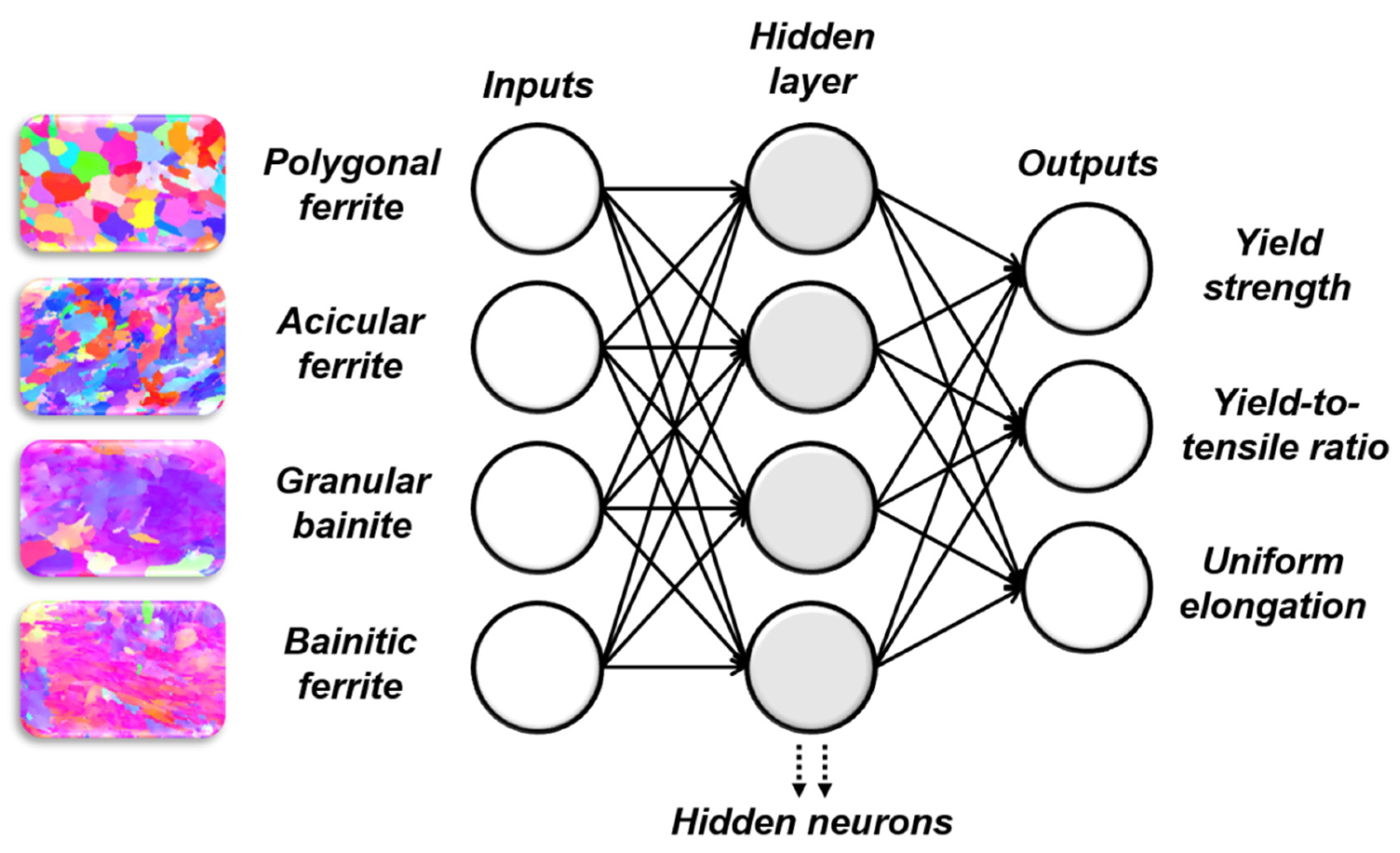
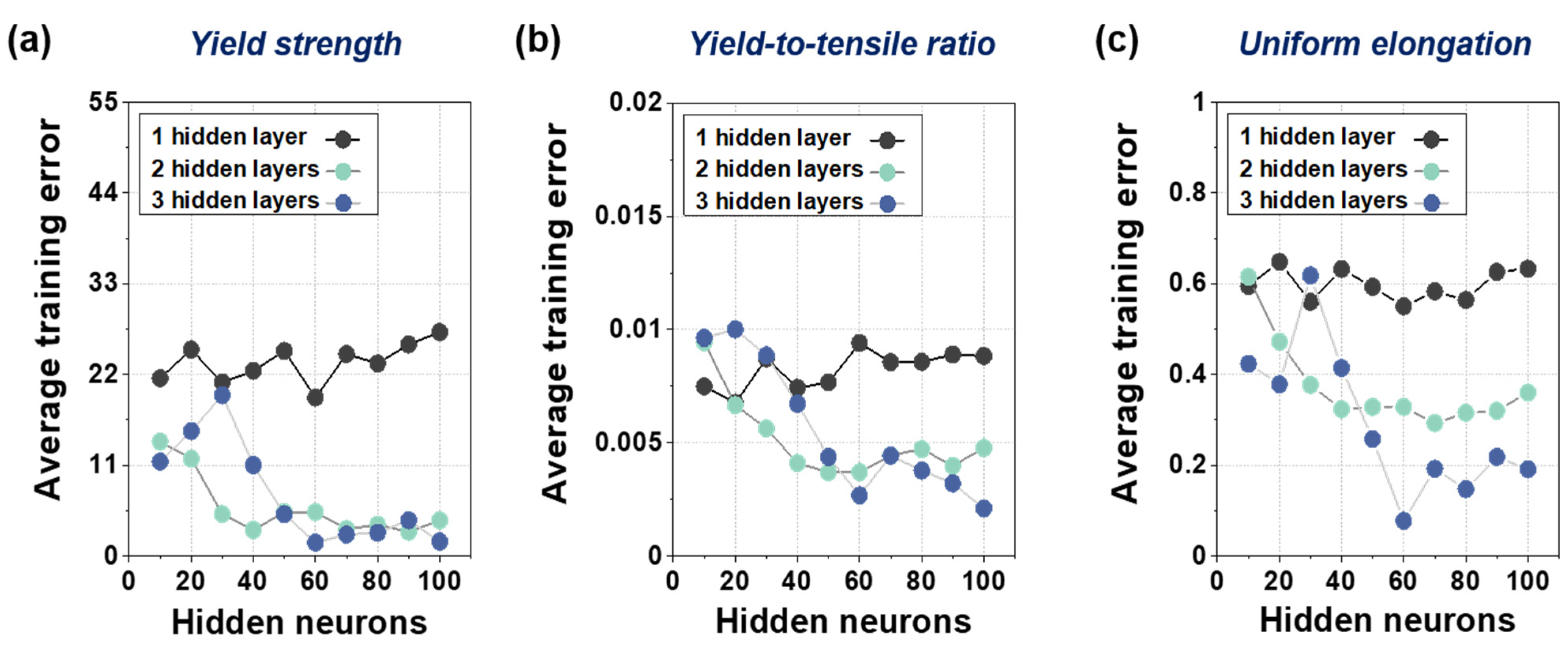
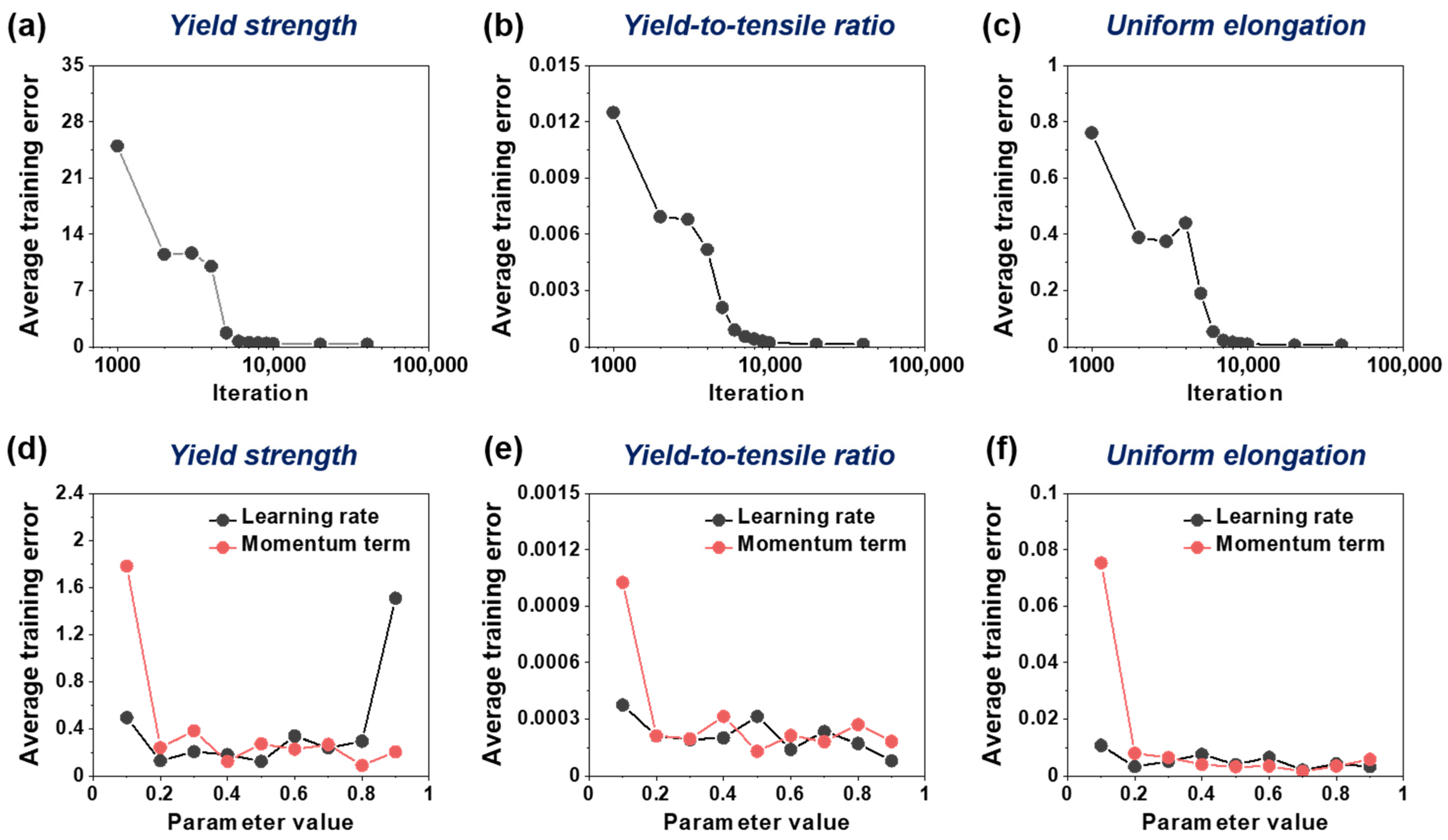
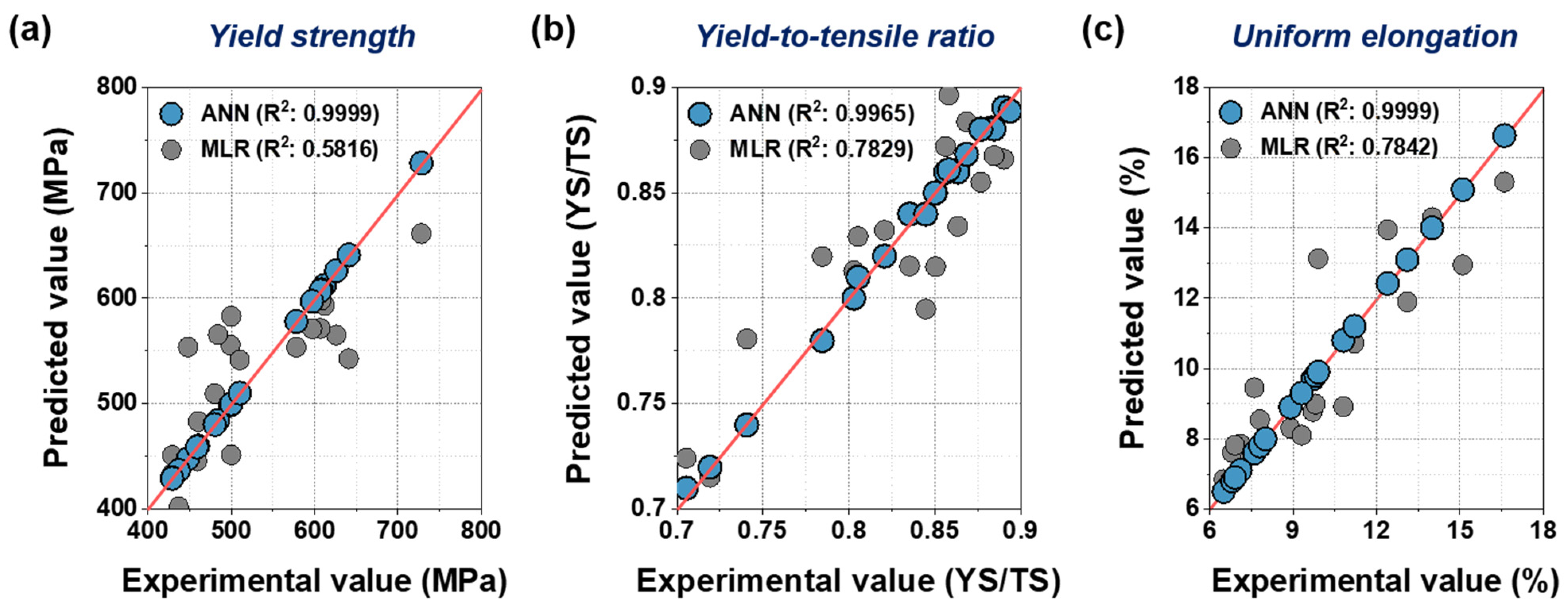
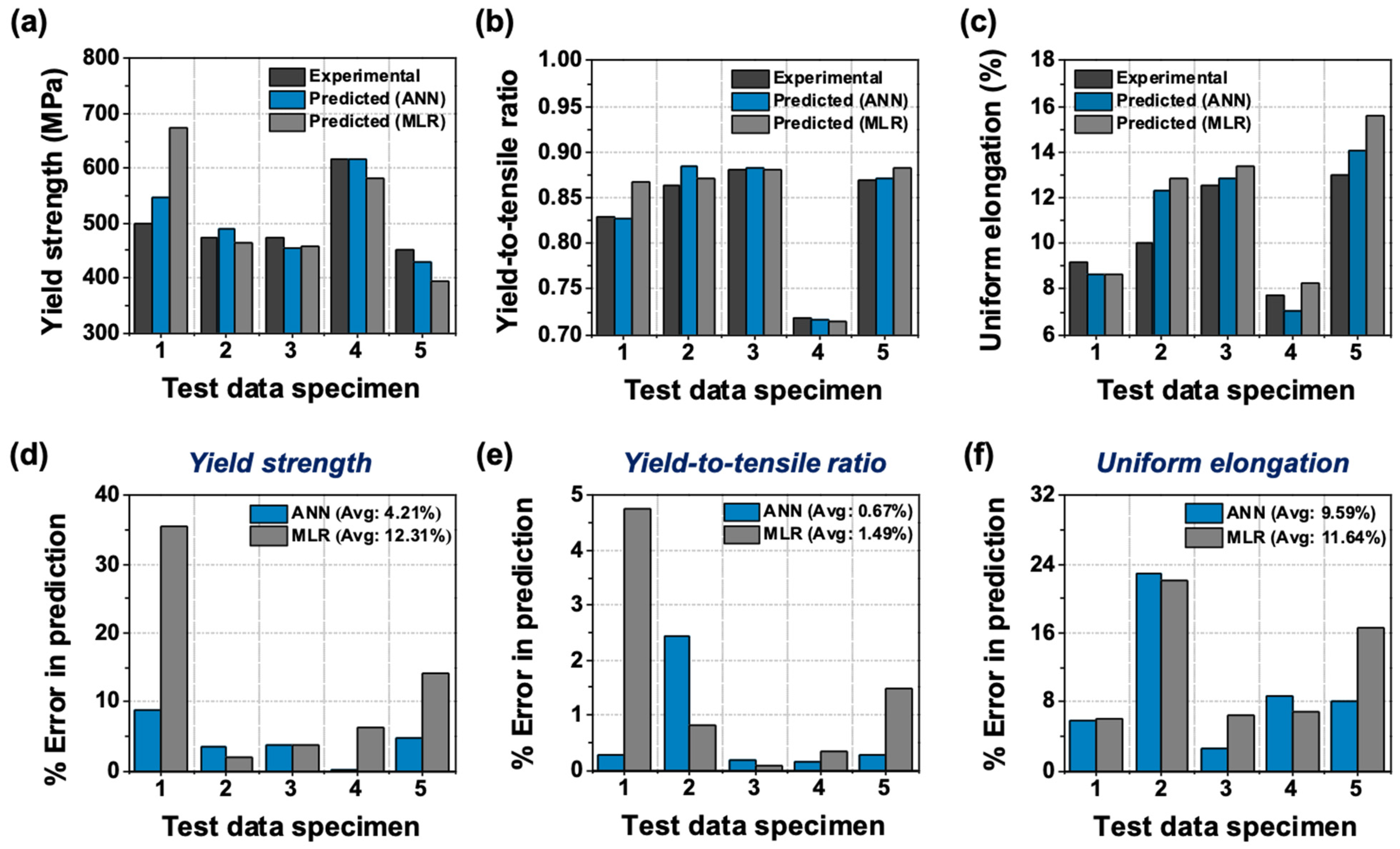



| Sample | Number | Reference | Constituent Fraction (%) | Tensile Properties | |||||
|---|---|---|---|---|---|---|---|---|---|
| Polygonal Ferrite | Acicular Ferrite | Granular Bainite | Bainitic Ferrite | Yield Strength (MPa) | Yield-to-Tensile Ratio | Uniform Elongation (%) | |||
| Training datasets | 1 | In this study | 8.6 | 57.3 | 19.1 | 15.5 | 448 | 0.80 | 10.8 |
| 2 | 4.2 | 77.5 | 9.6 | 8.7 | 499 | 0.82 | 8.9 | ||
| 3 | 9.1 | 58.6 | 20.2 | 12.2 | 578 | 0.84 | 9.7 | ||
| 4 | 5.1 | 55.9 | 11.2 | 27.9 | 500 | 0.85 | 9.3 | ||
| 5 | 12.8 | 35.1 | 28.7 | 23.5 | 484 | 0.84 | 9.8 | ||
| 6 | 26.2 | 49.5 | 12.5 | 11.9 | 480 | 0.86 | 11.2 | ||
| 7 | [5] | 54.8 | 35.6 | 0.0 | 8.1 | 500 | 0.86 | 9.9 | |
| 8 | 61.2 | 23.5 | 0.0 | 10.7 | 460 | 0.88 | 13.1 | ||
| 9 | 38.2 | 40.6 | 0.0 | 17.0 | 510 | 0.89 | 7.6 | ||
| 10 | 80.7 | 12.4 | 0.0 | 4.1 | 437 | 0.89 | 16.6 | ||
| 11 | 70.1 | 20.4 | 0.0 | 6.5 | 430 | 0.87 | 12.4 | ||
| 12 | 74.2 | 18.8 | 0.0 | 1.5 | 429 | 0.86 | 15.1 | ||
| 13 | [6] | 0.0 | 8.0 | 87.0 | 5.0 | 612 | 0.72 | 7.6 | |
| 14 | 0.0 | 18.0 | 9.0 | 73.0 | 728 | 0.74 | 6.5 | ||
| 15 | 0.0 | 76.0 | 18.0 | 6.0 | 626 | 0.78 | 7.1 | ||
| 16 | 0.0 | 11.0 | 78.0 | 11.0 | 608 | 0.71 | 6.8 | ||
| 17 | 0.0 | 87.0 | 12.0 | 2.0 | 641 | 0.81 | 7.8 | ||
| 18 | [7] | 70.6 | 3.5 | 0.0 | 23.8 | 459 | 0.88 | 14.0 | |
| 19 | 19.3 | 57.9 | 8.1 | 11.2 | 607 | 0.85 | 6.9 | ||
| 20 | 24.2 | 52.8 | 4.8 | 14.1 | 597 | 0.88 | 8.0 | ||
| Testing datasets | 1 | In this study | 7.2 | 71.5 | 15.8 | 5.6 | 675 | 0.87 | 8.7 |
| 2 | [5] | 56.3 | 28.4 | 0.0 | 13.2 | 489 | 0.88 | 12.3 | |
| 3 | 70.9 | 10.6 | 0.0 | 14.6 | 456 | 0.88 | 12.8 | ||
| 4 | [6] | 0.0 | 10.0 | 84.0 | 7.0 | 617 | 0.72 | 7.0 | |
| 5 | [7] | 75.2 | 18.6 | 0.0 | 4.9 | 429 | 0.87 | 14.0 | |
Publisher’s Note: MDPI stays neutral with regard to jurisdictional claims in published maps and institutional affiliations. |
© 2021 by the authors. Licensee MDPI, Basel, Switzerland. This article is an open access article distributed under the terms and conditions of the Creative Commons Attribution (CC BY) license (https://creativecommons.org/licenses/by/4.0/).
Share and Cite
Lee, S.-I.; Shin, S.-H.; Hwang, B. Application of Artificial Neural Network to the Prediction of Tensile Properties in High-Strength Low-Carbon Bainitic Steels. Metals 2021, 11, 1314. https://doi.org/10.3390/met11081314
Lee S-I, Shin S-H, Hwang B. Application of Artificial Neural Network to the Prediction of Tensile Properties in High-Strength Low-Carbon Bainitic Steels. Metals. 2021; 11(8):1314. https://doi.org/10.3390/met11081314
Chicago/Turabian StyleLee, Sang-In, Seung-Hyeok Shin, and Byoungchul Hwang. 2021. "Application of Artificial Neural Network to the Prediction of Tensile Properties in High-Strength Low-Carbon Bainitic Steels" Metals 11, no. 8: 1314. https://doi.org/10.3390/met11081314
APA StyleLee, S.-I., Shin, S.-H., & Hwang, B. (2021). Application of Artificial Neural Network to the Prediction of Tensile Properties in High-Strength Low-Carbon Bainitic Steels. Metals, 11(8), 1314. https://doi.org/10.3390/met11081314






